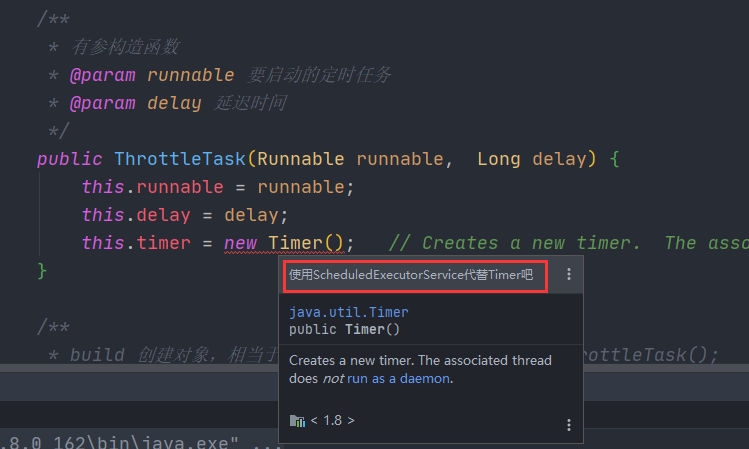您好,登录后才能下订单哦!
本篇内容介绍了“Java中的防抖和节流如何实现”的有关知识,在实际案例的操作过程中,不少人都会遇到这样的困境,接下来就让小编带领大家学习一下如何处理这些情况吧!希望大家仔细阅读,能够学有所成!
当持续触发事件时,一定时间段内没有再触发事件,事件处理函数才会执行一次,如果设定时间到来之前,又触发了事件,就重新开始延时。
防抖,即如果短时间内大量触发同一事件,都会重置计时器,等到事件不触发了,再等待规定的事件,才会执行函数。而这整个过程就触发了一次点赞函数到服务器。原理:设置一个定时器,设置在规定的时间后触发事件处理,每次触发事件都会重置计时器。
举例:很简单的例子,就是如果你疯狂的给朋友圈点赞再取消点赞,这个过程都会把计时器清空,等到你点累了不点了,等待0.5秒,才会触发函数,把你最终结果传给服务器。
问题1:那既然是这样,让前端做防抖不就好了嘛。答案是可以,但是会失去用户体验。本来有的用户点赞就是为了玩,现在你前端直接提示操作太快~请歇会。用户是不是就失去了乐趣,这一点还得参考QQ空间的点赞,虽然我不知道它是不是用了防抖,但是他把点赞,取消点赞做成了动画,这样每次用户操作的时候,都会跳出执行动画,大大增加了用户的体验性。
问题2:那么问题来了,在一定时间内,一直点击,就会重置计时器。那要是点击一天一夜,是不是他就不会在执行了呢。理论上是这样,但是人会累的嘛。总不能一直战斗是吧。所以人做不到,只能是机器、脚本来处理了,那也正好,防抖还能用来阻挡部分脚本攻击。
当持续触发事件时,保证在一定时间内只调用一次事件处理函数,意思就是说,假设一个用户一直触发这个函数,且每次触发小于既定值,函数节流会每隔这个时间调用一次。
想到这里,很多人就会想到一个作用,没错,就是防重复提交。但是这个业务时间比较难把控,所以还是建议用它来做一些无状态的操作比较好。比如说:刷新排行榜,前端看似一直在点击,其实后端为了防止接口崩掉,每1秒才执行真正的一次刷新。
防抖是将多次执行变为指定时间内不在触发之后,执行一次。
节流是将多次执行变为指定时间不论触发多少次,时间一到就执行一次
java实现防抖和节流的关键是Timer类和Runnable接口。
其中,Timer中关键方法cancel() 实现防抖 schedule() 实现节流。下面简单介绍一下这两个方法。
Timer##cancel():Timer.cancel() 被调用之后整个Timer 的 线程都会结束掉。
这就很好理解了,既然是做防抖,只要你在指定时间内触发,我直接 cancel()掉,就是取消掉,不让他执行。
Timer##schedule():用户调用 schedule() 方法后,要等待N秒的时间才可以第一次执行 run() 方法。
这个N是我们根据业务评估出来的时间,作为参数传进去。
package com.example.test01.zhangch;
import java.util.Timer;
import java.util.TimerTask;
/**
* @Author zhangch
* @Description java 防抖
* @Date 2022/8/4 18:18
* @Version 1.0
*/
@SuppressWarnings("all")
public class DebounceTask {
/**
* 防抖实现关键类
*/
private Timer timer;
/**
* 防抖时间:根据业务评估
*/
private Long delay;
/**
* 开启线程执行任务
*/
private Runnable runnable;
public DebounceTask(Runnable runnable, Long delay) {
this.runnable = runnable;
this.delay = delay;
}
/**
*
* @param runnable 要执行的任务
* @param delay 执行时间
* @return 初始化 DebounceTask 对象
*/
public static DebounceTask build(Runnable runnable, Long delay){
return new DebounceTask(runnable, delay);
}
//Timer类执行:cancel()-->取消操作;schedule()-->执行操作
public void timerRun(){
//如果有任务,则取消不执行(防抖实现的关键)
if(timer!=null){
timer.cancel();
}
timer = new Timer();
timer.schedule(new TimerTask() {
@Override
public void run() {
//把 timer 设置为空,这样下次判断它就不会执行了
timer=null;
//执行 runnable 中的 run()方法
runnable.run();
}
}, delay);
}
}可以看到,测试中,我 1 毫秒请求一次,这样的话,1秒内都存在连续请求,防抖操作永远不会执行。
public static void main(String[] args){
//构建对象,1000L: 1秒执行-->1秒内没有请求,在执行防抖操作
DebounceTask task = DebounceTask.build(new Runnable() {
@Override
public void run() {
System.out.println("防抖操作执行了:do task: "+System.currentTimeMillis());
}
},1000L);
long delay = 100;
while (true){
System.out.println("请求执行:call task: "+System.currentTimeMillis());
task.timerRun();
try {
//休眠1毫秒在请求
Thread.sleep(delay);
} catch (InterruptedException e) {
e.printStackTrace();
}
}
}结果如我们所料:
Connected to the target VM, address: '127.0.0.1:5437', transport: 'socket'
请求执行:call task: 1659609433021
请求执行:call task: 1659609433138
请求执行:call task: 1659609433243
请求执行:call task: 1659609433350
请求执行:call task: 1659609433462
请求执行:call task: 1659609433572
请求执行:call task: 1659609433681
请求执行:call task: 1659609433787
请求执行:call task: 1659609433893
请求执行:call task: 1659609433999
请求执行:call task: 1659609434106
请求执行:call task: 1659609434215
请求执行:call task: 1659609434321
请求执行:call task: 1659609434425
请求执行:call task: 1659609434534
测试2中,我们在请求了2秒之后,让主线程休息2秒,这个时候,防抖在1秒内没有在次触发,所以就会执行一次防抖操作。
public static void main(String[] args){
//构建对象,1000L:1秒执行
DebounceTask task = DebounceTask.build(new Runnable() {
@Override
public void run() {
System.out.println("防抖操作执行了:do task: "+System.currentTimeMillis());
}
},1000L);
long delay = 100;
long douDelay = 0;
while (true){
System.out.println("请求执行:call task: "+System.currentTimeMillis());
task.timerRun();
douDelay = douDelay+100;
try {
//如果请求执行了两秒,我们让他先休息两秒,在接着请求
if (douDelay == 2000){
Thread.sleep(douDelay);
}
Thread.sleep(delay);
} catch (InterruptedException e) {
e.printStackTrace();
}
}
}结果如我们所料,防抖任务触发了一次,休眠结束之后,请求就会在1毫秒内连续触发,防抖也就不会在次触发了。
请求执行:call task: 1659609961816
请求执行:call task: 1659609961924
请求执行:call task: 1659609962031
请求执行:call task: 1659609962138
请求执行:call task: 1659609962245
请求执行:call task: 1659609962353
防抖操作执行了:do task: 1659609963355
请求执行:call task: 1659609964464
请求执行:call task: 1659609964569
请求执行:call task: 1659609964678
请求执行:call task: 1659609964784
简易版:根据新手写代码习惯,对代码写法做了调整,但是不影响整体功能。这种写法更加符合我这种新手小白的写法。
public static void main(String[] args){
//要执行的任务,因为 Runnable 是接口,所以 new 对象的时候要实现它的 run方法
Runnable runnable = new Runnable() {
@Override
public void run() {
//执行打印,真实开发中,是这些我们的业务代码。
System.out.println("防抖操作执行了:do task: "+System.currentTimeMillis());
}
};
//runnable:要执行的任务,通过参数传递进去。1000L:1秒执行内没有请求,就执行一次防抖操作
DebounceTask task = DebounceTask.build(runnable,1000L);
//请求持续时间
long delay = 100;
//休眠时间,为了让防抖任务执行
long douDelay = 0;
//while 死循环,请求一直执行
while (true){
System.out.println("请求执行:call task: "+System.currentTimeMillis());
//调用 DebounceTask 防抖类中的 timerRun() 方法, 执行防抖任务
task.timerRun();
douDelay = douDelay+100;
try {
//如果请求执行了两秒,我们让他先休息两秒,在接着请求
if (douDelay == 2000){
Thread.sleep(douDelay);
}
Thread.sleep(delay);
} catch (InterruptedException e) {
e.printStackTrace();
}
}
}package com.example.test01.zhangch;
import java.util.Timer;
import java.util.TimerTask;
/**
* @Author zhangch
* @Description 节流
* @Date 2022/8/6 15:41
* @Version 1.0
*/
public class ThrottleTask {
/**
* 节流实现关键类
*/
private Timer timer;
private Long delay;
private Runnable runnable;
private boolean needWait=false;
/**
* 有参构造函数
* @param runnable 要启动的定时任务
* @param delay 延迟时间
*/
public ThrottleTask(Runnable runnable, Long delay) {
this.runnable = runnable;
this.delay = delay;
this.timer = new Timer();
}
/**
* build 创建对象,相当于 ThrottleTask task = new ThrottleTask();
* @param runnable 要执行的节流任务
* @param delay 延迟时间
* @return ThrottleTask 对象
*/
public static ThrottleTask build(Runnable runnable, Long delay){
return new ThrottleTask(runnable, delay);
}
public void taskRun(){
//如果 needWait 为 false,结果取反,表达式为 true。执行 if 语句
if(!needWait){
//设置为 true,这样下次就不会再执行
needWait=true;
//执行节流方法
timer.schedule(new TimerTask() {
@Override
public void run() {
//执行完成,设置为 false,让下次操作再进入 if 语句中
needWait=false;
//开启多线程执行 run() 方法
runnable.run();
}
}, delay);
}
}
}节流测试,每 2ms 请求一次,节流任务是每 1s 执行一次。真实效果应该是 1s 内前端发起了五次请求,但是后端只执行了一次操作
public static void main(String[] args){
//创建节流要执行的对象,并把要执行的任务传入进去
ThrottleTask task = ThrottleTask.build(new Runnable() {
@Override
public void run() {
System.out.println("节流任务执行:do task: "+System.currentTimeMillis());
}
},1000L);
//while一直执行,模拟前端用户一直请求后端
while (true){
System.out.println("前端请求后端:call task: "+System.currentTimeMillis());
task.taskRun();
try {
Thread.sleep(200);
} catch (InterruptedException e) {
e.printStackTrace();
}
}
}结果如我们所料
前端请求后端:call task: 1659772459363
前端请求后端:call task: 1659772459574
前端请求后端:call task: 1659772459780
前端请求后端:call task: 1659772459995
前端请求后端:call task: 1659772460205
节流任务执行:do task: 1659772460377
前端请求后端:call task: 1659772460409
前端请求后端:call task: 1659772460610
前端请求后端:call task: 1659772460812
前端请求后端:call task: 1659772461027
前端请求后端:call task: 1659772461230
节流任务执行:do task: 1659772461417
idea 爆红线了,强迫症的我受不了,肯定要解决它

脑子第一时间冒出来的是 @SuppressWarnings("all") 注解,跟所有的警告说拜拜~瞬间就清爽了

算了,压制警告总感觉是不负责任。总不能这样草草了事,那就来直面这个爆红。既然让我用 ScheduledExecutorService ,那简单,直接替换
public class ThrottleTask {
/**
* 节流实现关键类:
*/
private ScheduledExecutorService timer;
private Long delay;
private Runnable runnable;
private boolean needWait=false;
/**
* 有参构造函数
* @param runnable 要启动的定时任务
* @param delay 延迟时间
*/
public ThrottleTask(Runnable runnable, Long delay) {
this.runnable = runnable;
this.delay = delay;
this.timer = Executors.newSingleThreadScheduledExecutor();
}
/**
* build 创建对象,相当于 ThrottleTask task = new ThrottleTask();
* @param runnable 要执行的节流任务
* @param delay 延迟时间
* @return ThrottleTask 对象
*/
public static ThrottleTask build(Runnable runnable, Long delay){
return new ThrottleTask(runnable, delay);
}
public void taskRun(){
//如果 needWait 为 false,结果取反,表达式为 true。执行 if 语句
if(!needWait){
//设置为 true,这样下次就不会再执行
needWait=true;
//执行节流方法
timer.schedule(new TimerTask() {
@Override
public void run() {
//执行完成,设置为 false,让下次操作再进入 if 语句中
needWait=false;
//开启多线程执行 run() 方法
runnable.run();
}
}, delay,TimeUnit.MILLISECONDS);
}
}
}那么定时器 Timer 和 ScheduledThreadPoolExecutor 解决方案之间的主要区别是什么,我总结了三点...
定时器对系统时钟的变化敏感;ScheduledThreadPoolExecutor并不会。
定时器只有一个执行线程;ScheduledThreadPoolExecutor可以配置任意数量的线程。
TimerTask中抛出的运行时异常会杀死线程,因此后续的计划任务不会继续运行;使用ScheduledThreadExecutor–当前任务将被取消,但其余任务将继续运行。
“Java中的防抖和节流如何实现”的内容就介绍到这里了,感谢大家的阅读。如果想了解更多行业相关的知识可以关注亿速云网站,小编将为大家输出更多高质量的实用文章!
免责声明:本站发布的内容(图片、视频和文字)以原创、转载和分享为主,文章观点不代表本网站立场,如果涉及侵权请联系站长邮箱:is@yisu.com进行举报,并提供相关证据,一经查实,将立刻删除涉嫌侵权内容。